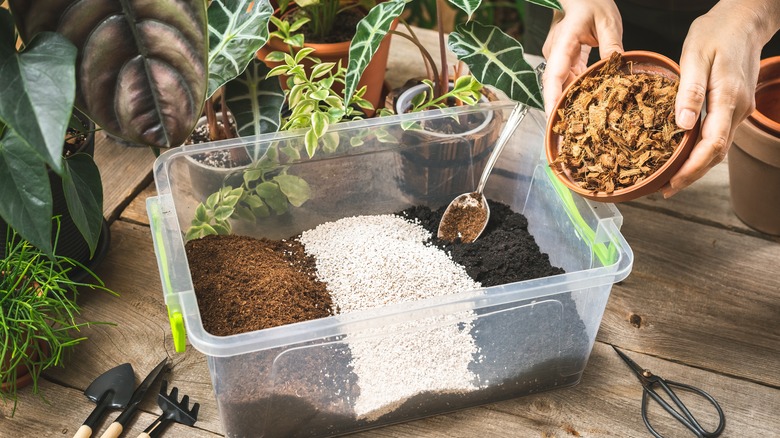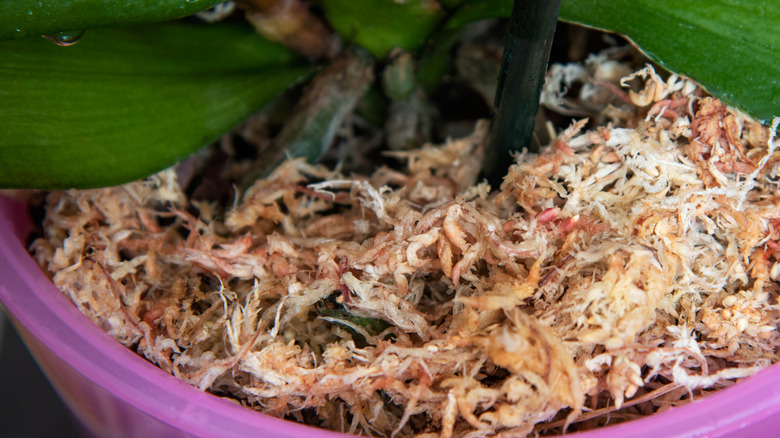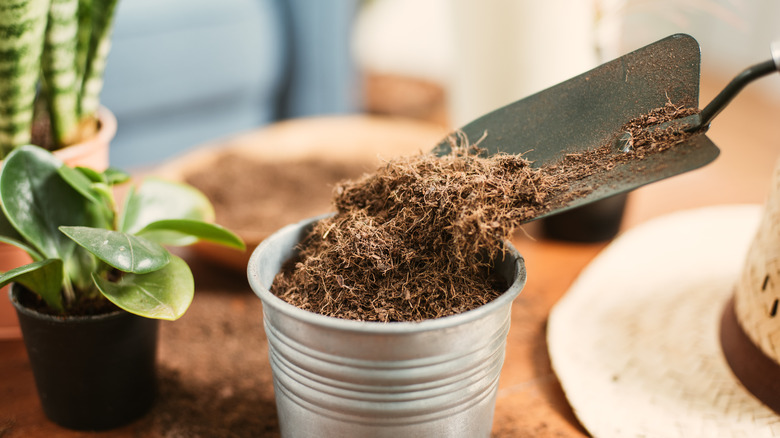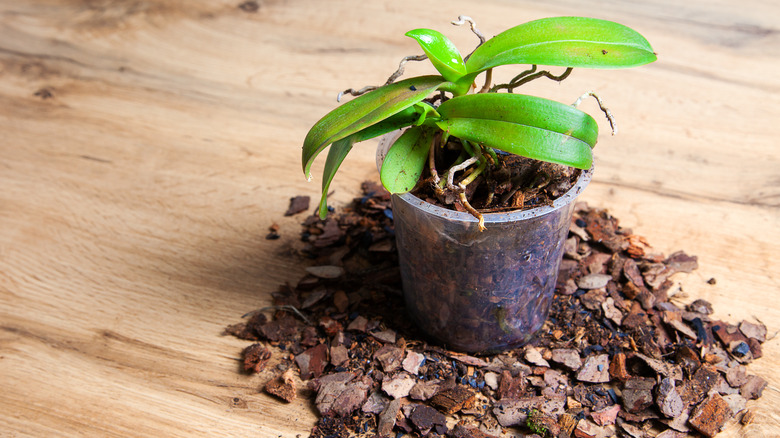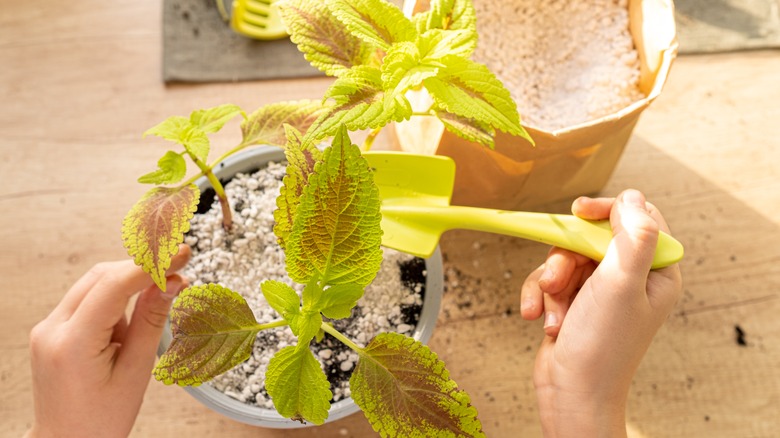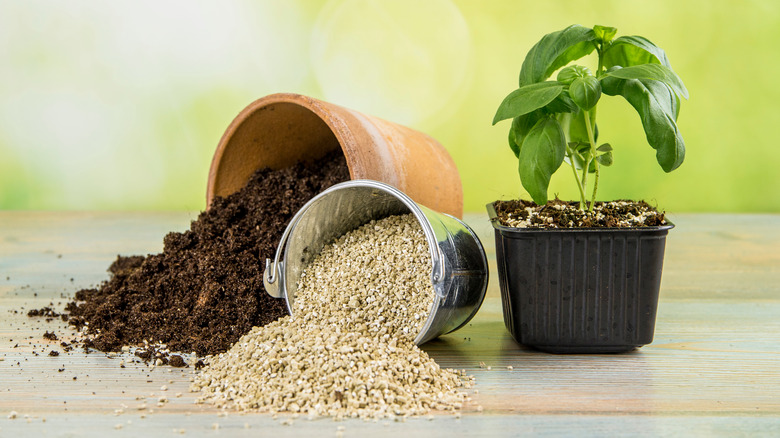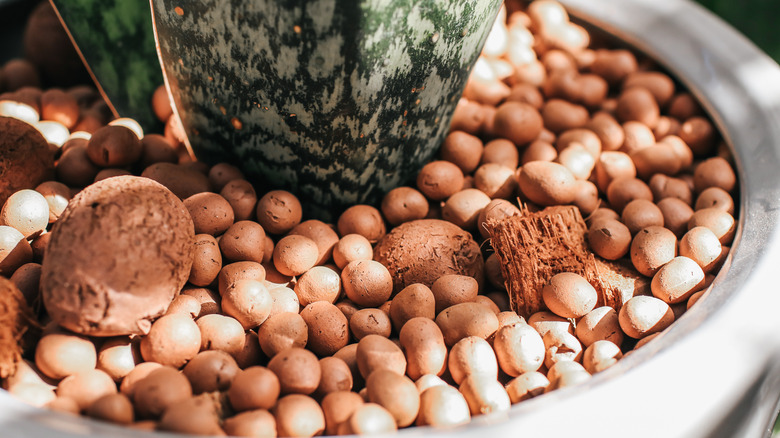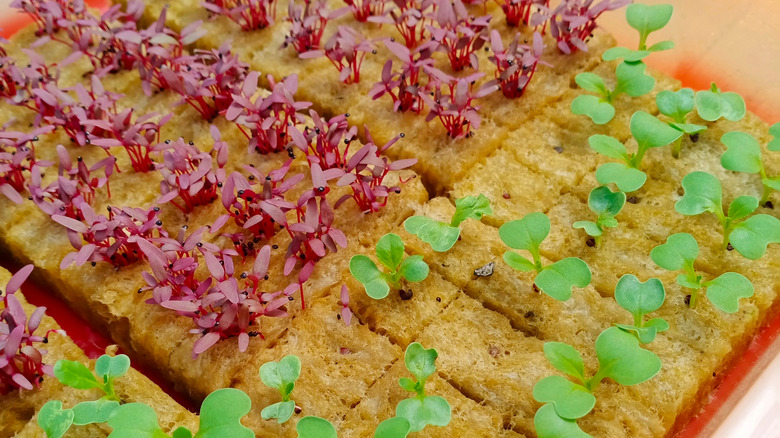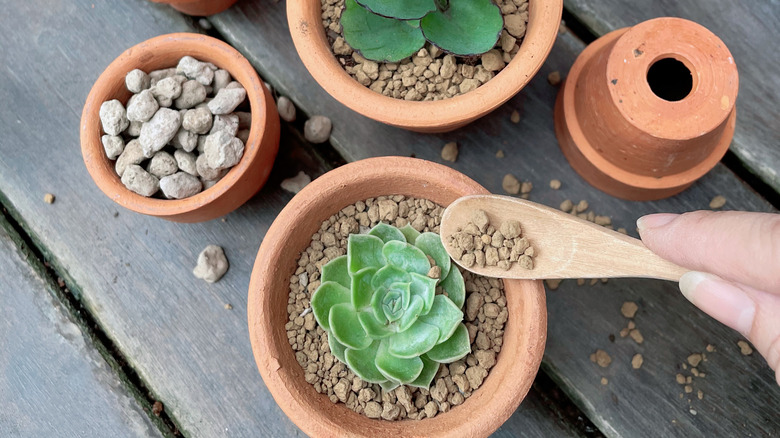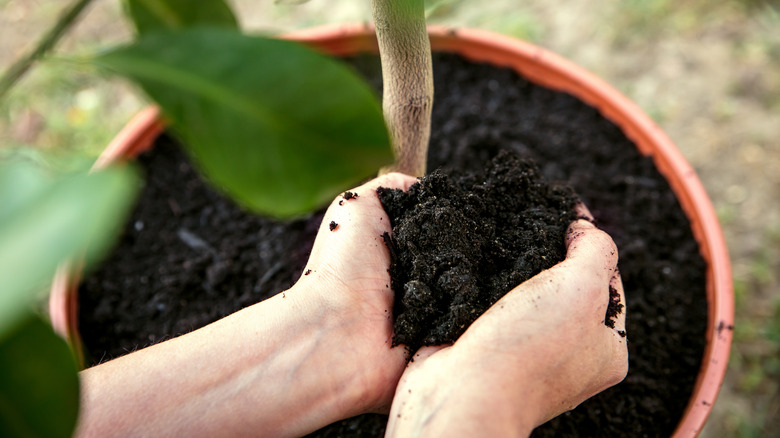10 Types Of Substrates For Container Gardening
If you've been enjoying a deep dive into best practices for houseplant care, you've likely seen the term substrate linked to any substances from dirt to rocks to clay balls and glass. It can be confusing, and you may be starting to wonder what gives.
Put simply, a substrate is the base upon which your plant lives. Gardening newbies may think that only translates directly to soil, but there's a whole lot more to it than that. Yes, potting mix is a substrate. However, it's nowhere near the only (or even best) one; there are many alternatives.
Each type of substrate has ways of helping a plant live, grow, and obtain nourishment. Purdue University Extension advises that it's important to educate yourself on the properties of different substrate layers to understand how they function alongside plants and pick the best one each time you come home with a new seedling. Some substrates are dense and highly nourishing; others are porous. Some are acidic; others are neutral or lean towards the alkaline end of the pH scale.
At the end of the gardening day, there's no reason to despair from information overload. Below, we're sharing the basic definitions and important qualities of the 10 substrates you're most likely to come across at the garden center. One read-through, and you'll be ready to talk like a pro the next time you shop at your local nursery.
1. Sphagnum peat moss
The Sphagnum botanical genus contains 160 species of mosses, many of which come together to form sphagnum peat moss. Most commercially grown sphagnum peat moss comes from peatlands in Canada that are 10,000 years old. This substrate is highly sought after for its ability to retain air and water — up to 20 times its weight (via Premier Tech Horticulture). Essentially this means the growing medium stays moist without getting heavy. Sphagnum peat moss grows in highly acidic environments and has a pH level of 3.5 to 4.5. This makes it a beneficial substrate for other acid-loving plants, such as blueberries, per the University of Minnesota Extension.
Sphagnum peat moss has been a favored substrate and soil conditioner for professional and hobby gardeners for quite some time. From an environmental standpoint, however, there is disagreement on whether its use should continue. Unfortunately, in 2017, the Washington Post reported that the extraction and harvesting of peat moss might contribute to global warming with the release of excessive amounts of carbon dioxide. In fact, the United Nations added that fires within the peatlands make up 5% of carbon emissions caused by humans.
2. Coconut coir
Coconut or coco coir is derived from the exterior fibers (known as the pith) of coconuts, most of which come from Sri Lanka and India. It can be used on its own as an individual substrate or mixed into soil as an amendment. Coconut coir is used in both standard and hydroponic gardening.
Sometimes called coco peat, it has much in common with sphagnum peat moss and can usually act as a suitable alternative. According to the Food and Agriculture Organization of the United Nations, coir is a natural fiber and, therefore, referred to as a geo-textile. It retains moisture, encourages seed germination, and is very slow to decompose. In fact, a layer of coconut coir can benefit soil as an amendment for up to three years.
Since they are widely available, renewable, and sustainable, coconut products have been deemed among the best alternatives to peat moss. In most garden centers, you'll find a few variations. Coco husks can replace standard mulch. Coco chips are flaky and come in different grades like fine, medium, and coarse.
3. Pine bark
Per Oregon State University Extension, the bark of pine trees is particularly useful as an amendment to thick, muddy, clay soil. It will help tremendously with aeration and loosening up the muck. Pine bark is also very quick to absorb water. This type of substrate is acidic with a low pH that usually falls between 3.4 to 4.8. On its own, pine bark can be used to grow orchids.
In addition to pine, the bark of fir trees is also used. Ask Gardening says it can take years for these substrates to break down — which is a good thing in this context — with fir tending to last even longer than pine. Both offer superior durability and allow for increased air circulation among the roots of plants that need it the most. As you might expect, epiphytes benefit from and thrive in a standalone substrate of bark.
Like coco chips, pine and fir bark are sold in different grades. Fine bark will absorb more water than the larger medium or coarse grade chunks.
4. Perlite
Perlite is a porous and pH-neutral substrate resembling polystyrene or Styrofoam. The two appear so similar on the surface that some people confuse them and try to use Styrofoam in their garden and potting soil mixes. This is a recipe for disaster, explains Air Sea Containers, a company that produces packaging material. Unlike perlite, Styrofoam will not increase drainage or aerate the soil, nor will it decompose.
Actual perlite is ancient in origins, dating back to the third century B.C. when farmers discovered excessively fertile soil beds near volcanoes, according to Trees.com. It is a naturally-occurring volcanic glass that pops into its spongy form when heated to extreme temperatures. As such, perlite has the apropos nickname of volcanic popcorn.
Generally speaking, perlite is used as a soil conditioner or additive. It primarily aids in drainage and aeration. Perlite is everywhere — you've likely seen the puffy white kernels mixed into or sitting on top of the soil of almost every plant you've taken home from a garden center. In some hydroponic instances, perlite can be used as a standalone substrate.
5. Vermiculite
Vermiculite is another PH-neutral substrate with a different feel and origination. The Vermiculite Association describes it as a flaky, brown-colored mineral made up of hydrated magnesium, iron, aluminum, and silicate. In gardening, vermiculite retains moisture and improves soil aeration. Trees.com reports that it is especially beneficial for germinating seeds and rooting cuttings from mature plants.
Aside from its popularity as a potting mix additive, vermiculite is used for insulation and fire protection because it is noncombustible and can withstand extremely high temperatures. And if you're scratching your head thinking you could swear you heard something about vermiculite having a connection to asbestos, worry not. The Vermiculite Association explains that 30 years ago, there was an isolated incident of a vermiculite deposit mixing with and becoming contaminated by asbestos minerals. The affected mine was closed in 1990, and there have been no further occurrences. Per the association, vermiculite is perfectly safe to use.
6. Expanded clay pebbles
Expanded clay pebbles, sometimes called hydroton or leca, are balls made of clay and minerals. They get heated to an extreme temperature, making them expand into porous, lightweight rocks. They are pH-neutral and ideal for retaining moisture and nutrients. The clay itself does not have any nutritional value; however, the pores in each clay ball create passageways for the transmission of water, nutrients, and airflow. Expanded clay pebbles work best for plants like beans and parsley that naturally perform well in clay environments, per Planteli.
Though they are most popular in hydroponic gardening, Trees.com explains how they can be used in traditional soil gardening as well. You may see the balls labeled as pellets — they are the same. Either mix them with potting mix at a ratio of 1/3 pellets to 2/3 soil or place a handful of pellets at the bottom of your pot and add soil on top.
Trees.com notes that this growing media should be rinsed before use. You can actually leave the clay balls to soak for up to a day. Add a diluted concentration of fertilizer to the soaking water, which the pellets will absorb until they are saturated. This way, they will gradually feed your plants without you needing to remember when to fertilize them.
7. Growstones
Natural organic products may seem like the obvious choices, but the ecological damage from harvesting so many of them is an evident strain on Earth's renewable resources. Enter Growstones, which represent the next level of environmental preservation and are most commonly used in hydroponic gardening. They are made from 100% recycled glass pulverized into powder and baked into rock-like patties. The force from the naturally-occurring gases as they escape from the oven's heat creates the air pockets that make the final product porous.
Even if you're not into hydroponics, the original Growstone company has created a product you may be interested in called Gnat Nix. This is a non-toxic, chemical-free insect deterrent made from 100% recycled glass. Gnat Nix keeps those insanely annoying tiny black fungus gnats out of your house by creating a physical barrier between them and the precious roots of your beloved flora. Simply sprinkle the product as a top layer over the soil of your houseplants, and it will stave off female insects from laying eggs. Per the HTG Supply site, it's been scientifically proven to work.
8. Rockwool
The hydroponic masters at Canna Gardening recommend rockwool as a highly effective substrate. All you need to do is spin your molten lava rocks into super fine fiber threads — no big whoop. Or to make things easier you can buy it at the store. You'll find rockwool in a number of different shapes and sizes, from cubed blocks to flat slabs, and even in a granulated form that works particularly well in hanging baskets.
Rockwool originated as a construction industry standard for thermal insulation. Over time it became popular in commercial horticulture, eventually making its way to the hobbyists.
Rockwool drains quickly, yet it can retain as much as 80% of a nutrient solution. This is great for plants that can feed off the rockwool without getting bogged down by heavy moisture or, much worse, standing water. Since it's a rock, this substrate will never break down and can therefore be rotated into new crops many times over. Wash it in boiling water before transferring it to a new plant to ensure it doesn't bring any pathogens.
9. Pumice
Bet you didn't know that the same pumice stones used to exfoliate dry skin can be used as a potting medium. Pumice, or more specifically crushed lava rock, is a volcanic rock that is so lightweight it can float on water. It can be used as a top layer for potted plants or an amendment mixed into potting soils to increase aeration and drainage.
Gardener Debra Lee Baldwin, who some consider the Queen of Succulents, says pumice is perfect for her plants. One of its best tricks is retaining high moisture levels for up to two days and then slowly releasing the water. This keeps plants from drowning and roots from getting soggy and irreparably damaged. Similarly, Bonsaischule Wenddorf, a bonsai supplier out of Germany, depends on this soilless substrate for superior air circulation to the roots of his picky trees.
Fine grain pumice is well suited for container plants, while larger grains up to 3/8 of an inch perform well in outdoor gardens or raised beds.
10. Compost
Compost is rich, gooey, garden goodness at its best; happy farmers call it black gold. This is where the worms prefer to do their handiwork. Compost is so good that the Natural Resources Defense Council offers a Composting 101 guide to get as many of us interested in DIYing our own as possible. At its core, composting is nature at work. The naturally-occurring process of organic waste matter breaking down into nutrition helps new plants grow. Isn't that beautiful?
Commercially produced compost can be purchased at the store or made at home. Many common household items can be collected from the kitchen or raked up outside and tossed into a compost bin. If you're uninterested in the potential mess from a pile of compost you know you'll end up ignoring for far too long, some communities offer compost pickup programs alongside regular trash and recycling.
Using compost as a substrate or adding it as an amendment is one of the best ways to enrich your soil with essential nutrients such as magnesium, calcium, zinc, and iron, among others. Honestly, it's pretty hard to go wrong with this stuff. Black gold!
